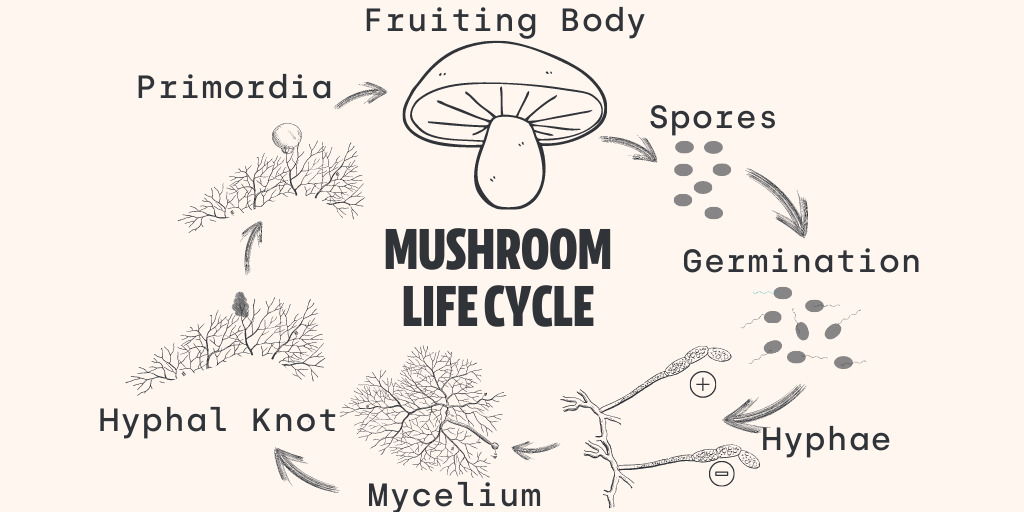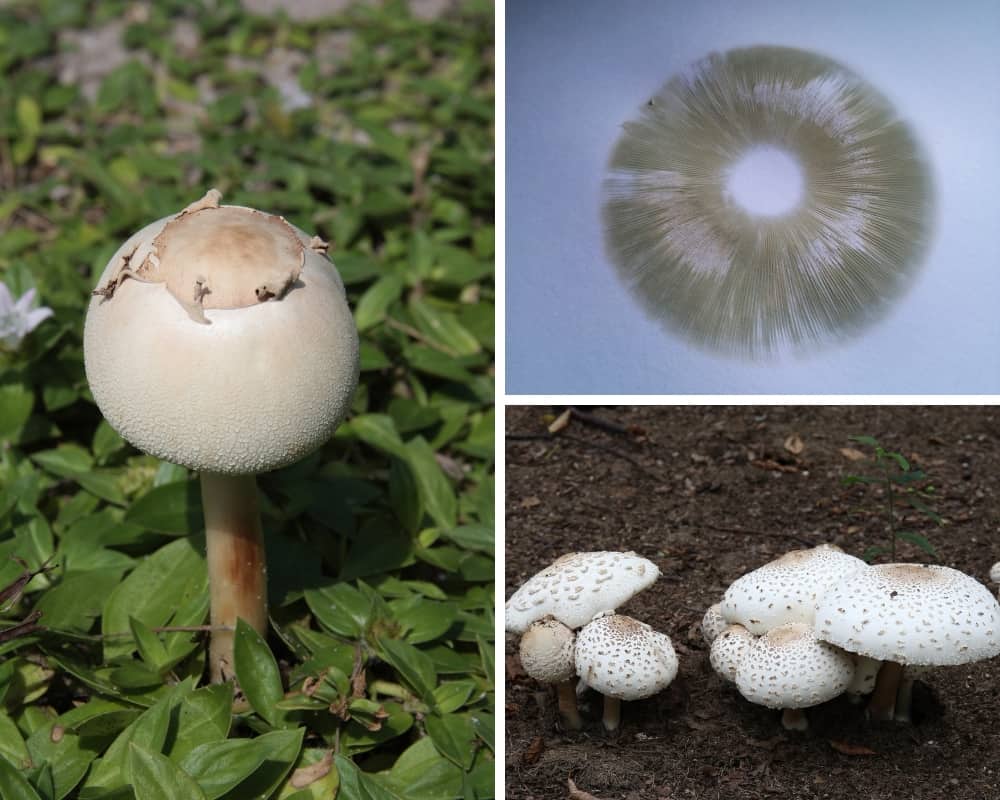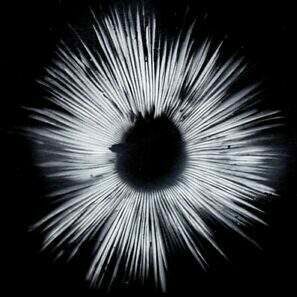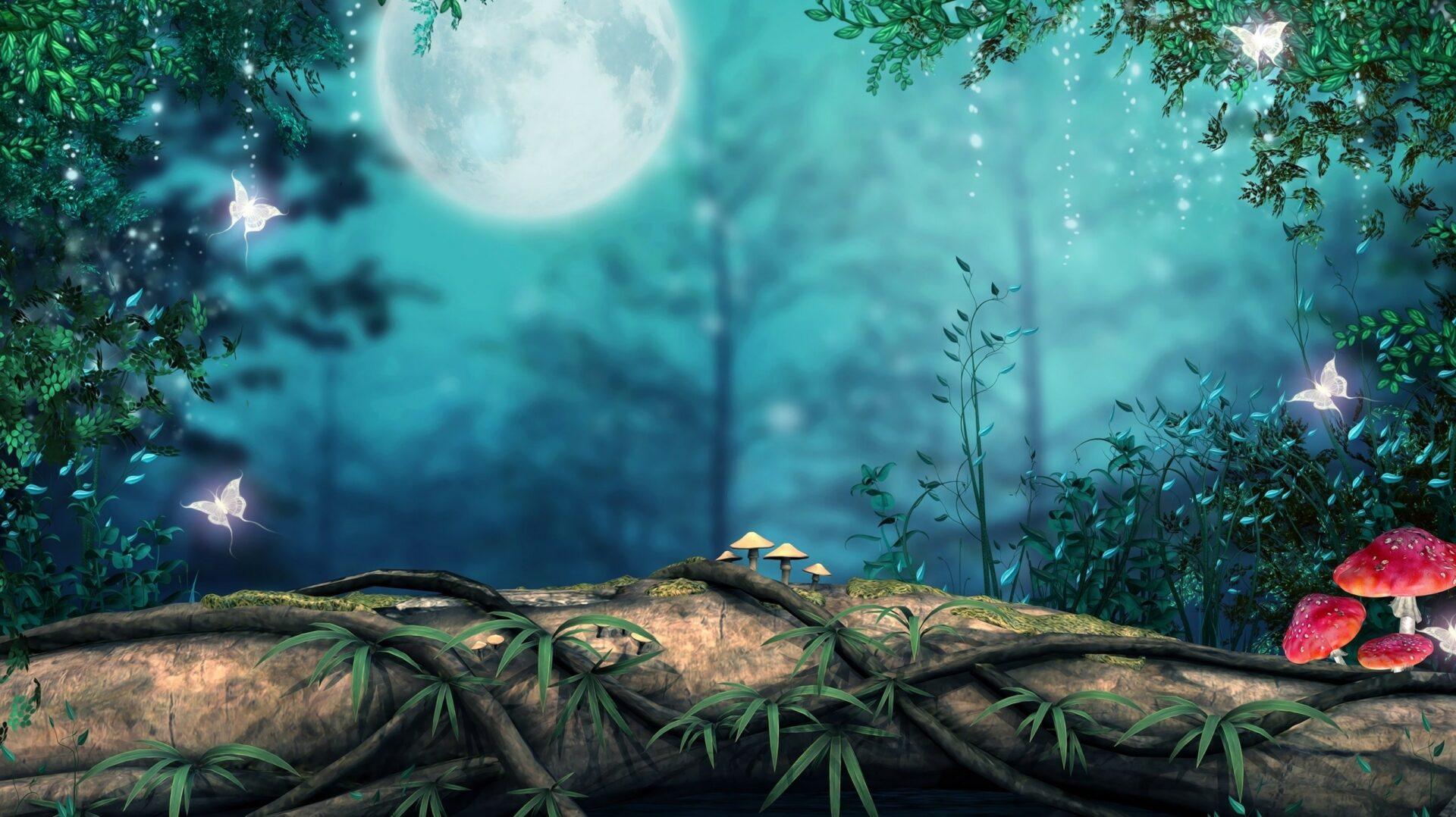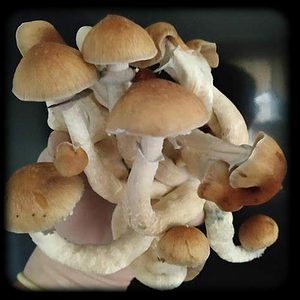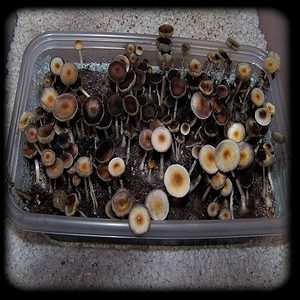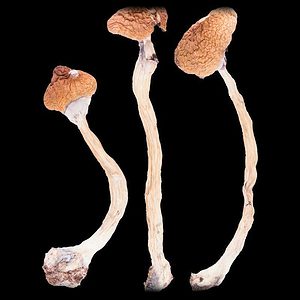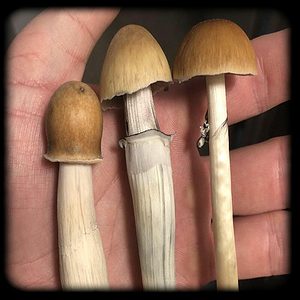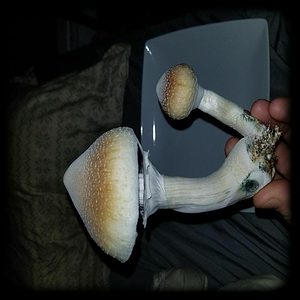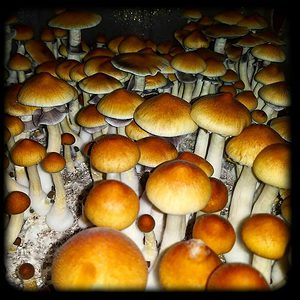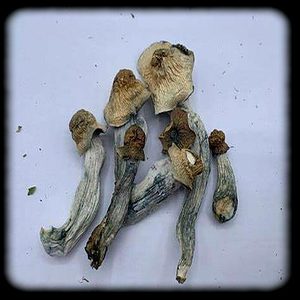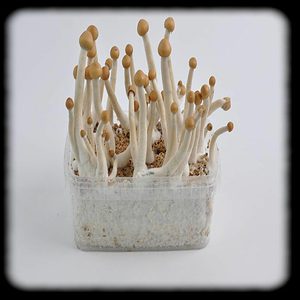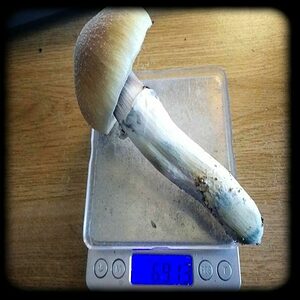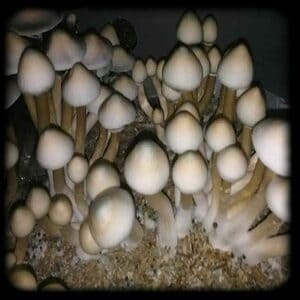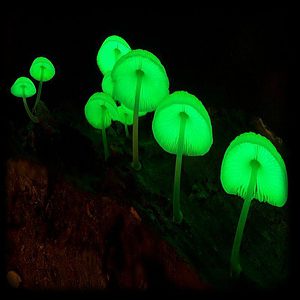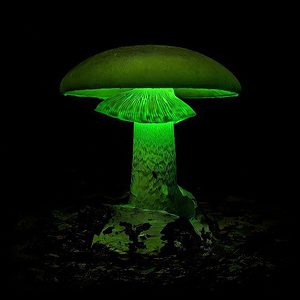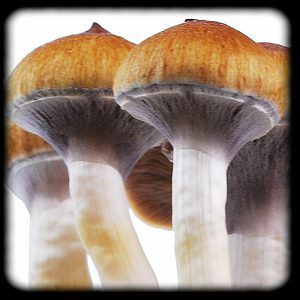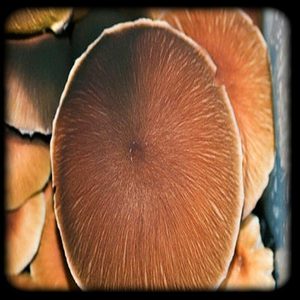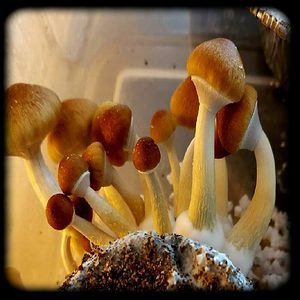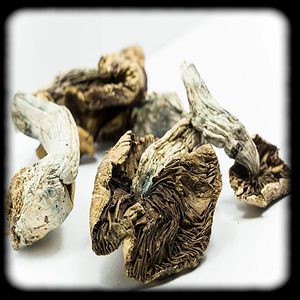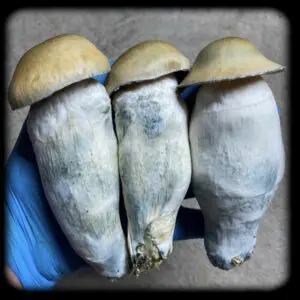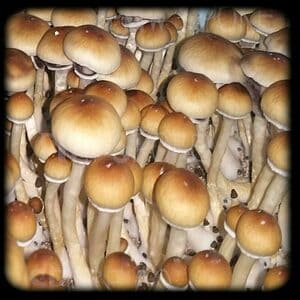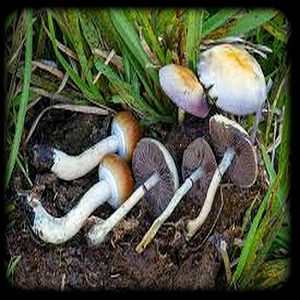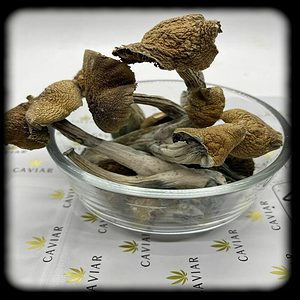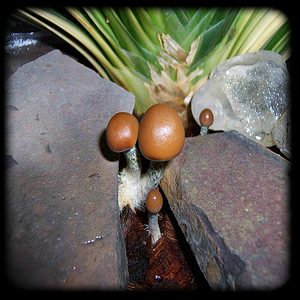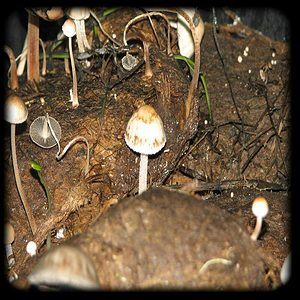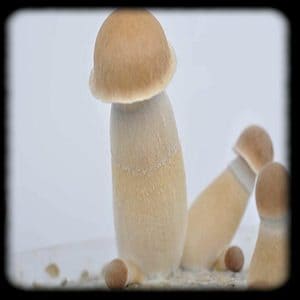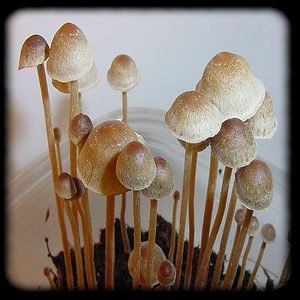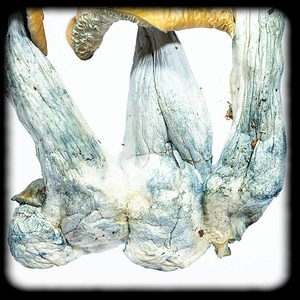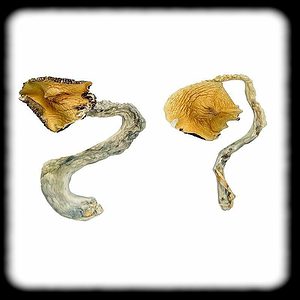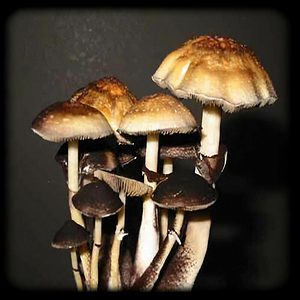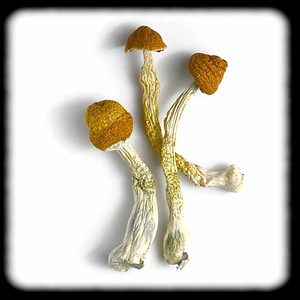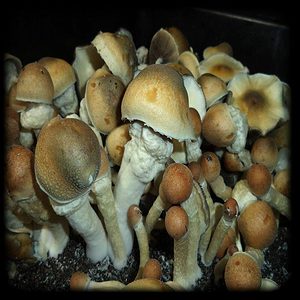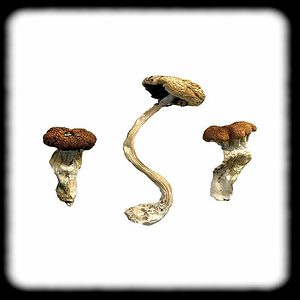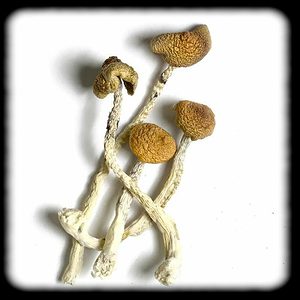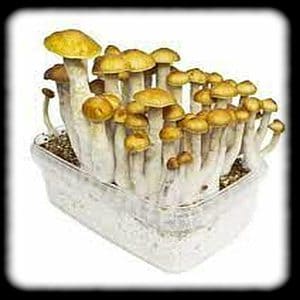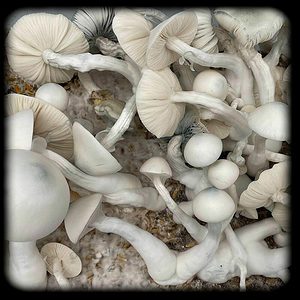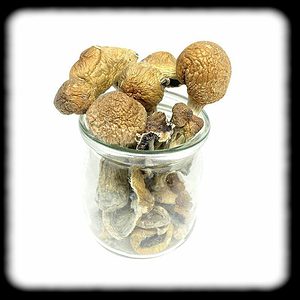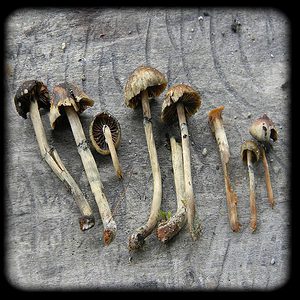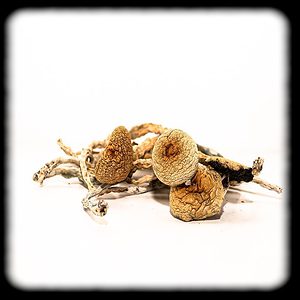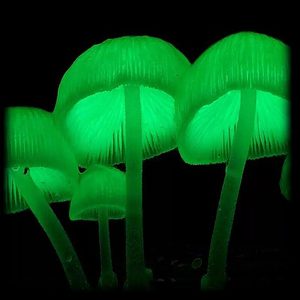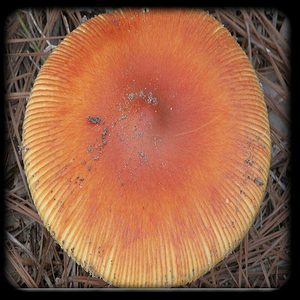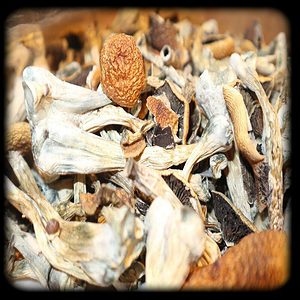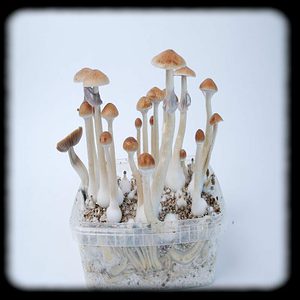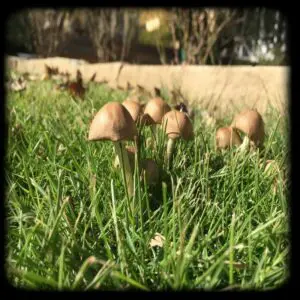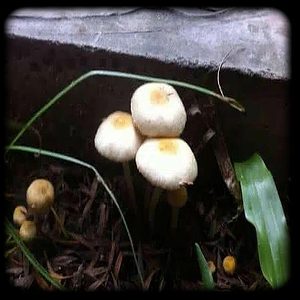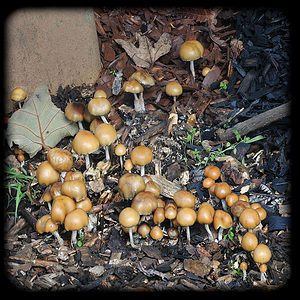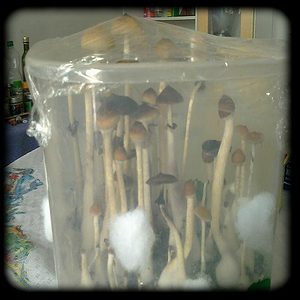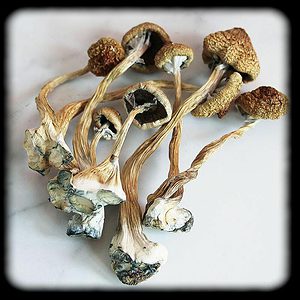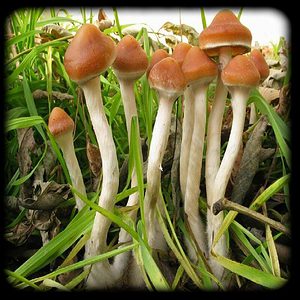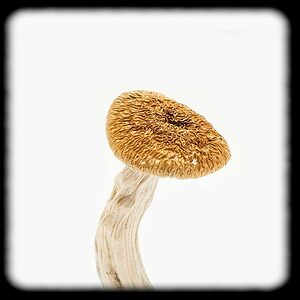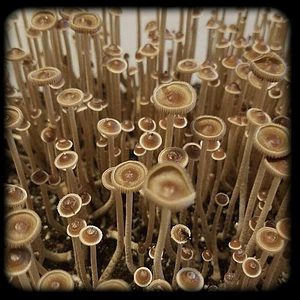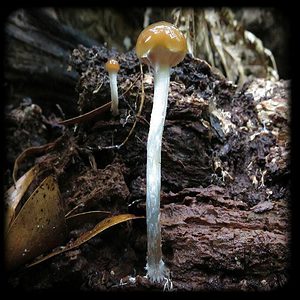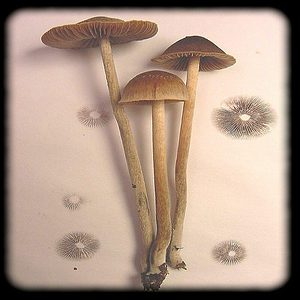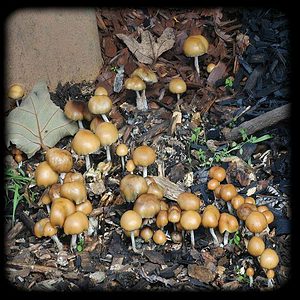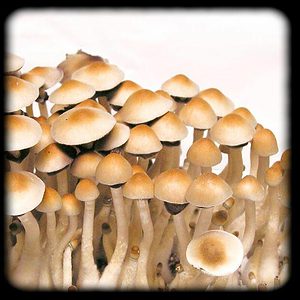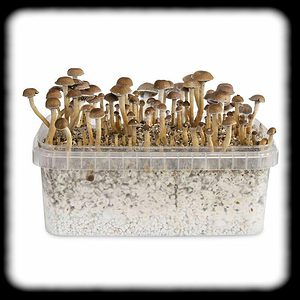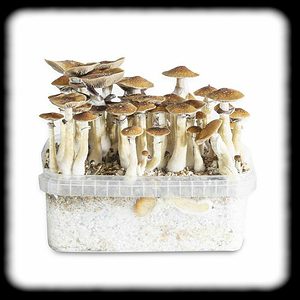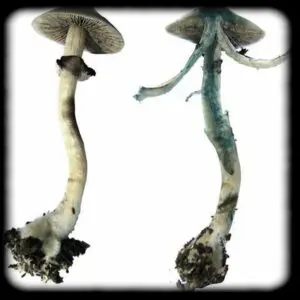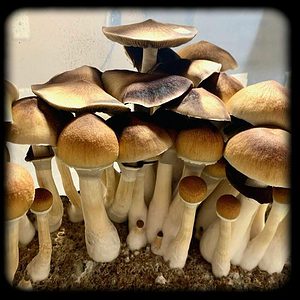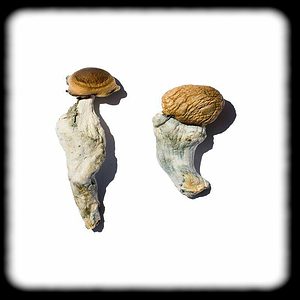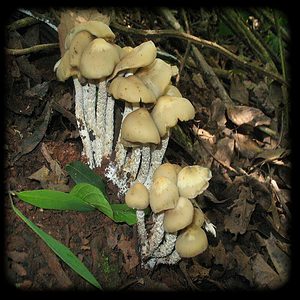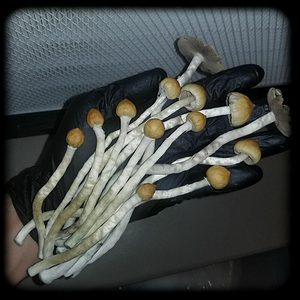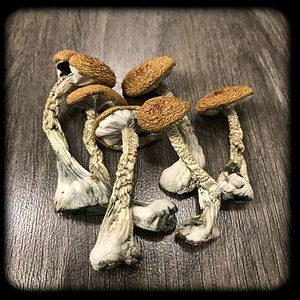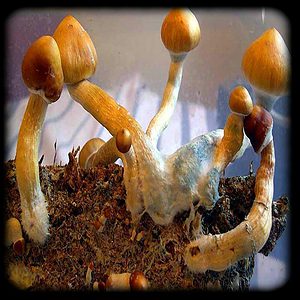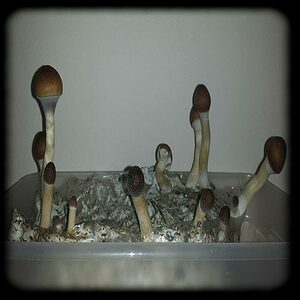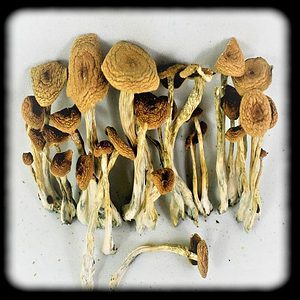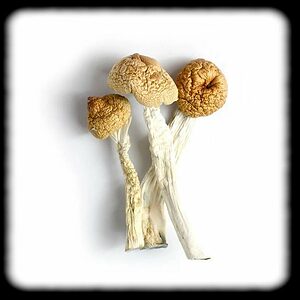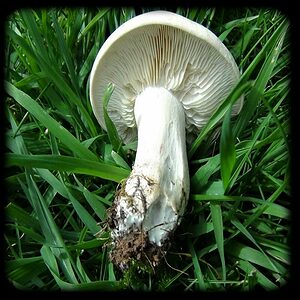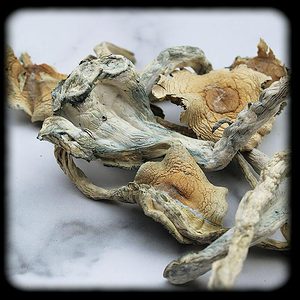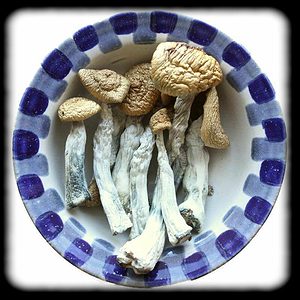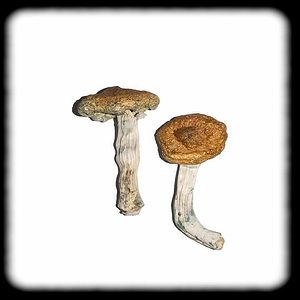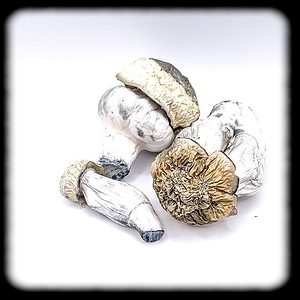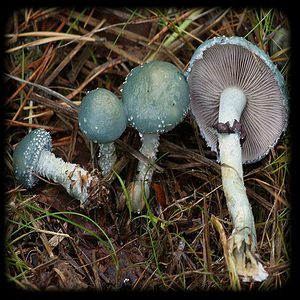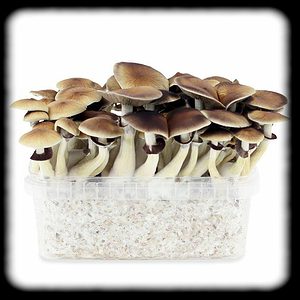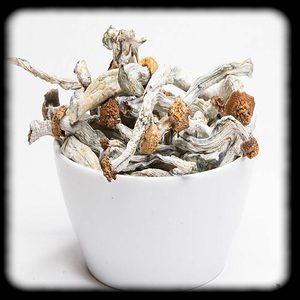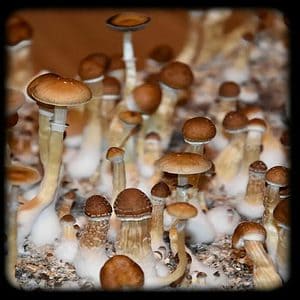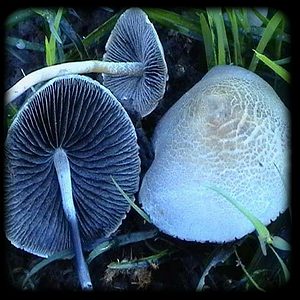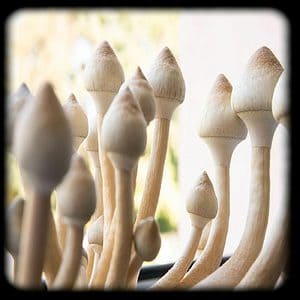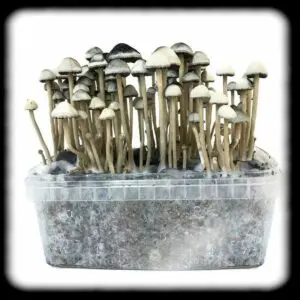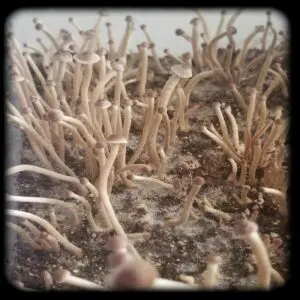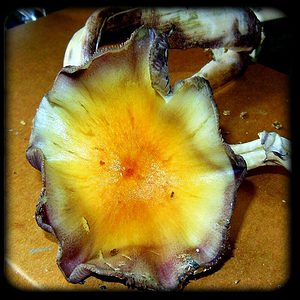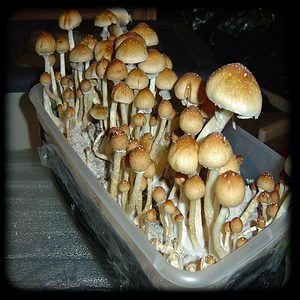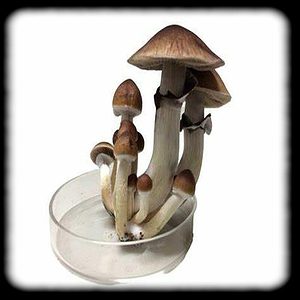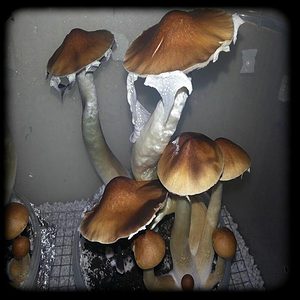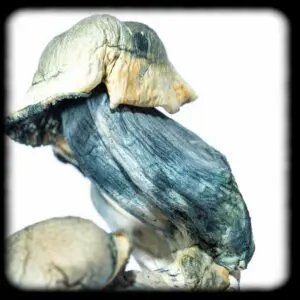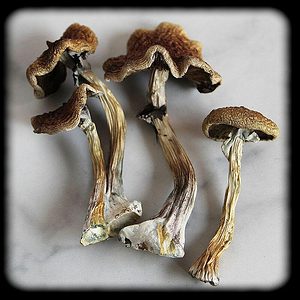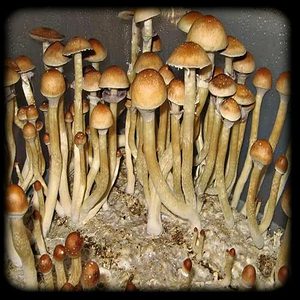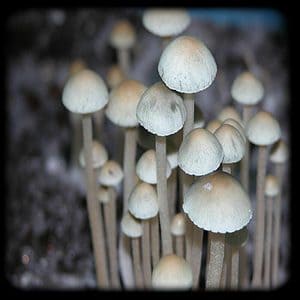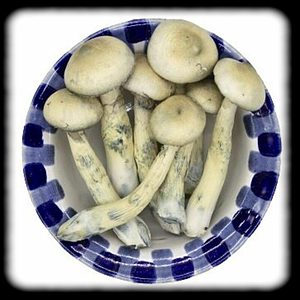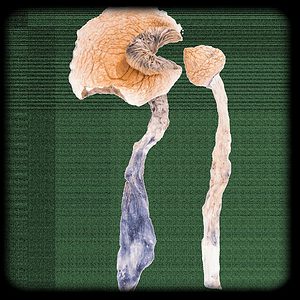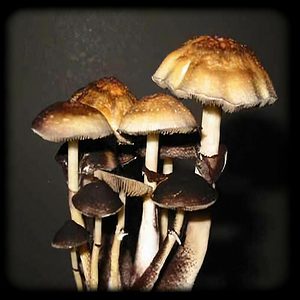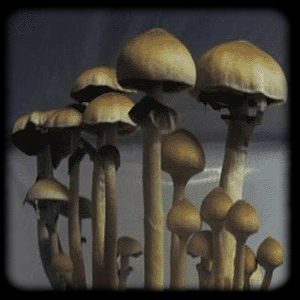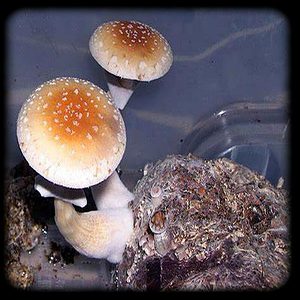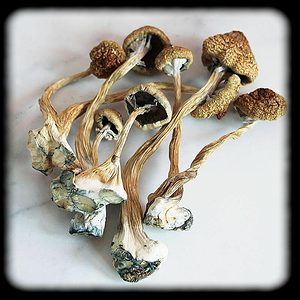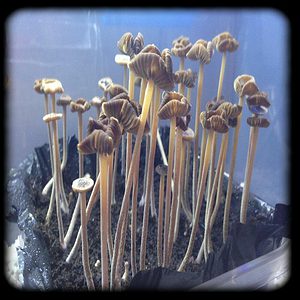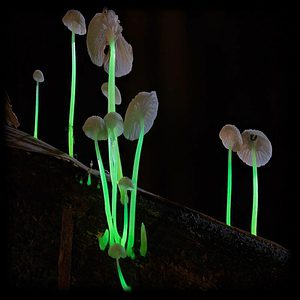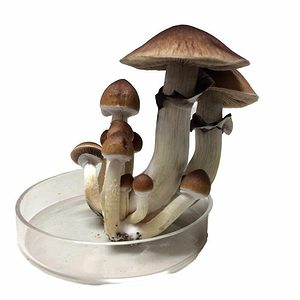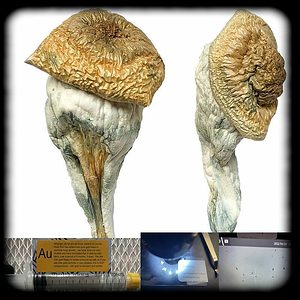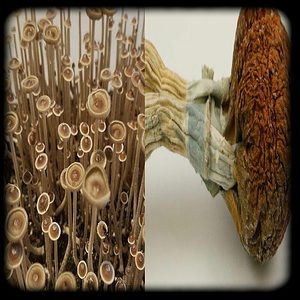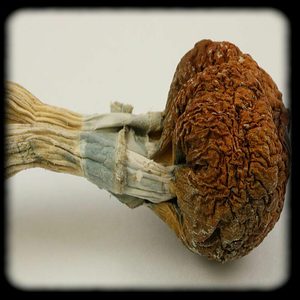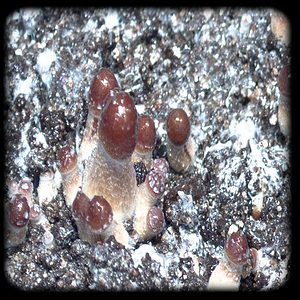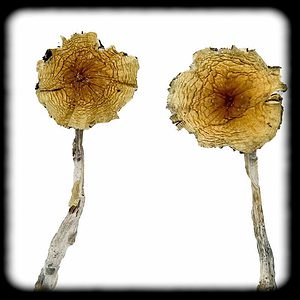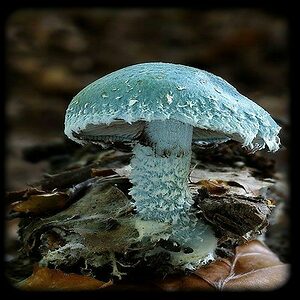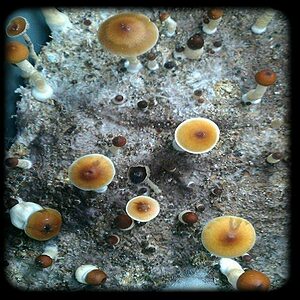Learning how to make a mushroom spore print is an essential skill for any budding mycologist.
If you’re interested in foraging for wild mushrooms, spore printing can help identify exactly what mushroom you’ve found.
If instead, you’re interested in growing mushrooms from spores, you need to know how to properly collect and store the spores to complete the mushroom life cycle.
Either way, the spore printing process is basically the same.
WHAT ARE SPORES? Although not technically accurate, mushroom spores can be thought of as “seeds ”, with each spore containing exactly half of the genetic information required to produce an actual mushroom.
The spores are released into the environment from the gills (or pores) located under the cap of a mature mushroom. They then get carried away by air currents, and if they land in the right place, will eventually produce fine white strands of mycelium.
The mycelium will grow and eventually produce a new mushroom fruiting body, starting the cycle all over again.
Spores come in all different shapes, colors and sizes depending on the species- they really are amazing! And to think that a single mushroom can release billions of spores into the air.
That being said, the only factor visible to the human eye is the spore color, which is why taking a proper spore print is such an important characteristic for identifying mushrooms.
Ban Nathon Magic Mushroom Magic Mushroom Spore Syringe with 24K Gold Infusion
Cuban Magic Mushroom Magic Mushroom Spore Syringe with 24K Gold Infusion
Hillbilly Magic Mushroom Magic Mushroom Spore Syringe with 24K Gold Infusion
Palenque Mexico Magic Mushroom Magic Mushroom Spore Syringe with 24K Gold Infusion
Colorado Magic Mushroom Magic Mushroom Spore Syringe with 24K Gold Infusion
Psilocybe Natalensis Magic Mushroom Spore Syringe with 24K Gold Infusion
Jedi Mind Fuck Magic Mushroom Magic Mushroom Spore Syringe with 24K Gold Infusion
Glowing Teacher Magic Mushroom glow in the dark Bioluminescent Fungi from miracle farms spores Magic Mushroom Spore Syringe with 24K Gold Infusion
Cambodian Magic Mushroom Magic Mushroom Spore Syringe with 24K Gold Infusion
Penis Envy 6 Magic Mushroom Magic Mushroom Spore Syringe with 24K Gold Infusion
Mestizo Magic Mushroom Magic Mushroom Spore Syringe with 24K Gold Infusion
largest magic mushrrom 4 pack special 1 Magic Mushroom Spore Syringe with 24K Gold Infusion
Albino Treasure Coast Magic Mushroom Magic Mushroom Spore Syringe with 24K Gold Infusion
U.S. Virgin Islands Magic Mushroom Magic Mushroom Spore Syringe with 24K Gold Infusion
Luminous Lucy Magic Mushroom 2 Magic Mushroom Spore Syringe with 24K Gold Infusion
Luminous Lucy Magic Mushroom 3 Magic Mushroom Spore Syringe with 24K Gold Infusion
Amazonian Magic Mushroom special Magic Mushroom Spore Syringe with 24K Gold Infusion
Koh Samui Magic Mushroom Magic Mushroom Spore Syringe with 24K Gold Infusion
Corumba Magic Mushroom Magic Mushroom Spore Syringe with 24K Gold Infusion
Xapuri Magic Mushroom Magic Mushroom Spore Syringe with 24K Gold Infusion
Ajax Magic Mushroom Magic Mushroom Spore Syringe with 24K Gold Infusion
Lizard King Magic Mushroom Magic Mushroom Spore Syringe with 24K Gold Infusion
Penis Envy Magic Mushroom special Magic Mushroom Spore Syringe with 24K Gold Infusion
Nepal Chitwan Magic Mushroom 12 Magic Mushroom Spore Syringe with 24K Gold Infusion
Acadian Coast Mushroom Magic Mushroom Spore Syringe with 24K Gold Infusion
B in the wild Magic Mushroom Spore Syringe with 24K Gold Infusion
Elephant Dung Magic Mushroom Magic Mushroom Spore Syringe with 24K Gold Infusion
Plantasia Mystery Magic Mushroom Magic Mushroom Spore Syringe with 24K Gold Infusion
Thai Magic Mushroom Magic Mushroom Spore Syringe with 24K Gold Infusion
Penis Envy Uncut Magic Mushroom Magic Mushroom Spore Syringe with 24K Gold Infusion
Psilocybe Tampanensis Florida by MiracleFarms.org Psilocybe Tampanensis Magic Mushroom Spore Syringe with 24K Gold Infusion
Albino Melmac Magic Mushroom Magic Mushroom Spore Syringe with 24K Gold Infusion
Panama Magic Mushroom Magic Mushroom Spore Syringe with 24K Gold Infusion
b plus strain Magic Mushroom Spore Syringe with 24K Gold Infusion
Menace Magic Mushroom.jpeg Magic Mushroom Spore Syringe with 24K Gold Infusion
Hanoi Magic Mushroom Magic Mushroom Spore Syringe with 24K Gold Infusion
Mississippi Magic Mushroom Magic Mushroom Spore Syringe with 24K Gold Infusion
Mexican Dutch King Magic Mushroom Magic Mushroom Spore Syringe with 24K Gold Infusion
Mexican Albino Magic Mushroom Magic Mushroom Spore Syringe with 24K Gold Infusion
Elephant Gate Magic Mushroom Magic Mushroom Spore Syringe with 24K Gold Infusion
E4K Willy Myco Magic Mushroom Magic Mushroom Spore Syringe with 24K Gold Infusion
Kathmandu Nepal Magic Mushroom Magic Mushroom Spore Syringe with 24K Gold Infusion
Malaysian Magic Mushroom Magic Mushroom Spore Syringe with 24K Gold Infusion
McKennaii Magic Mushroom Magic Mushroom Spore Syringe with 24K Gold Infusion
largest magic mushrrom 4 pack special 2 Magic Mushroom Spore Syringe with 24K Gold Infusion
Lipa Yai Thai Magic Mushroom Magic Mushroom Spore Syringe with 24K Gold Infusion
Bix Mex Magic Mushroom Magic Mushroom Spore Syringe with 24K Gold Infusion
largest magic mushrrom 4 pack special 4 Magic Mushroom Spore Syringe with 24K Gold Infusion
Aztec God Magic Mushroom Magic Mushroom Spore Syringe with 24K Gold Infusion
Nepal Chitwan Magic Mushroom 5 Magic Mushroom Spore Syringe with 24K Gold Infusion
aa leucistic cubensis magic mushroom Magic Mushroom Spore Syringe with 24K Gold Infusion
golden teacher Magic Mushroom Spore Syringe with 24K Gold Infusion
Jack Frost Magic Mushroom Magic Mushroom Spore Syringe with 24K Gold Infusion
Huautla Oaxaca Magic Mushroom Magic Mushroom Spore Syringe with 24K Gold Infusion
Nepal Chitwan Magic Mushroom 3 Magic Mushroom Spore Syringe with 24K Gold Infusion
Mazatapec Magic Mushroom Magic Mushroom Spore Syringe with 24K Gold Infusion
Brazilian Magic Mushroom Magic Mushroom Spore Syringe with 24K Gold Infusion
Rusty Whyte Magic Mushroom Magic Mushroom Spore Syringe with 24K Gold Infusion
Albino Golden Teacher Magic Mushroom Magic Mushroom Spore Syringe with 24K Gold Infusion
Glowing Teacher miraclefarmspores Magic Mushroom Magic Mushroom Spore Syringe with 24K Gold Infusion
Oak Ridge Magic Mushroom Magic Mushroom Spore Syringe with 24K Gold Infusion
Texas Orange Cap Magic Mushroom Magic Mushroom Spore Syringe with 24K Gold Infusion
R44 Magic Mushroom Magic Mushroom Spore Syringe with 24K Gold Infusion
Treasure Coast Magic Mushroom Magic Mushroom Spore Syringe with 24K Gold Infusion
Texas Magic Mushroom Magic Mushroom Spore Syringe with 24K Gold Infusion
Albino Penis Envy Magic Mushroom APE Magic Mushroom Spore Syringe with 24K Gold Infusion
Ban Thurian magic mushroom Magic Mushroom Spore Syringe with 24K Gold Infusion
Allen Strain magic mushroom 2 Magic Mushroom Spore Syringe with 24K Gold Infusion
Dancing Tiger Magic Mushroom Magic Mushroom Spore Syringe with 24K Gold Infusion
South African Transkei magic mushroom Magic Mushroom Spore Syringe with 24K Gold Infusion
Psilocybe Azurescens Magic Mushrom Magic Mushroom Spore Syringe with 24K Gold Infusion
Chilean Magic Mushroom 2 Magic Mushroom Spore Syringe with 24K Gold Infusion
Psilocybe Tampanensis magic mushroom special Magic Mushroom Spore Syringe with 24K Gold Infusion
Tasmanian Magic Mushroom Magic Mushroom Spore Syringe with 24K Gold Infusion
Psilocybe Tampanensis Magic Mushroom Spore Syringe with 24K Gold Infusion
largest magic mushrrom 4 pack special 3 Magic Mushroom Spore Syringe with 24K Gold Infusion
Psilocybe tampanensis is a very rare psychedelic mushroom in the family Hymenogastraceae. Magic Mushroom Spore Syringe with 24K Gold Infusion
John Allen Strain Magic Mushroom Magic Mushroom Spore Syringe with 24K Gold Infusion
Golden Mammoth Magic Mushroom Magic Mushroom Spore Syringe with 24K Gold Infusion
A Strain 12cc mushroom spore syringe Magic Mushroom Spore Syringe with 24K Gold Infusion
Costa Rican Magic Mushroom Magic Mushroom Spore Syringe with 24K Gold Infusion
PF Classic Magic Mushroom Magic Mushroom Spore Syringe with 24K Gold Infusion
Peruvian Magic Mushroom 2 Magic Mushroom Spore Syringe with 24K Gold Infusion
Blue Meanies magic mushroom Magic Mushroom Spore Syringe with 24K Gold Infusion
Pacifica Exotica Spora Amazon Magic Mushroom Magic Mushroom Spore Syringe with 24K Gold Infusion
Hawaiian Magic Mushroom special 2 Magic Mushroom Spore Syringe with 24K Gold Infusion
South American Magic Mushroom Magic Mushroom Spore Syringe with 24K Gold Infusion
Trans Envy Magic Mushroom Magic Mushroom Spore Syringe with 24K Gold Infusion
T3 Magic Mushroom Magic Mushroom Spore Syringe with 24K Gold Infusion
Pakalensis Cubensis Magic Mushroom Magic Mushroom Spore Syringe with 24K Gold Infusion
Z strain Magic Mushroom Magic Mushroom Spore Syringe with 24K Gold Infusion
ape revert magic mushroom Magic Mushroom Spore Syringe with 24K Gold Infusion
Ban Hua Thanon magic mushroom Magic Mushroom Spore Syringe with 24K Gold Infusion
SG30 Magic Mushroom Magic Mushroom Spore Syringe with 24K Gold Infusion
Alcabenzi Magic Mushroom Magic Mushroom Spore Syringe with 24K Gold Infusion
Puerto Rican Magic Mushroom Magic Mushroom Spore Syringe with 24K Gold Infusion
Chitwan Nepal Magic Mushroom Magic Mushroom Spore Syringe with 24K Gold Infusion
Orissa India Magic Mushroom Magic Mushroom Spore Syringe with 24K Gold Infusion
La Primavera Magic Mushroom Magic Mushroom Spore Syringe with 24K Gold Infusion
Gulf Coast Magic Mushroom Magic Mushroom Spore Syringe with 24K Gold Infusion
Mexicube Magic Mushroom Magic Mushroom Spore Syringe with 24K Gold Infusion
Vietnamese magic musghroom Magic Mushroom Spore Syringe with 24K Gold Infusion
Panaeolus Cyanescens Mezcala Magic Mushroom Magic Mushroom Spore Syringe with 24K Gold Infusion
Albino Cambodian Magic Mushroom Magic Mushroom Spore Syringe with 24K Gold Infusion
Yeti Magic Mushroom Magic Mushroom Spore Syringe with 24K Gold Infusion
F Florida Magic Mushroom Magic Mushroom Spore Syringe with 24K Gold Infusion
Xapuri Magic Mushroom 2 Magic Mushroom Spore Syringe with 24K Gold Infusion
Quezon Philippines Magic Mushroom Magic Mushroom Spore Syringe with 24K Gold Infusion
Stropharia magic mushroom 2 Magic Mushroom Spore Syringe with 24K Gold Infusion
GT Magic Mushroom Spore Syringe with 24K Gold Infusion
Trinity Magic Mushroom 2 Magic Mushroom Spore Syringe with 24K Gold Infusion
Australian Magic Mushroom Magic Mushroom Spore Syringe with 24K Gold Infusion
Blue Meanies magic mushroom special Magic Mushroom Spore Syringe with 24K Gold Infusion
Albino A Magic Mushroom Magic Mushroom Spore Syringe with 24K Gold Infusion
Hawaiian Magic Mushroom Magic Mushroom Spore Syringe with 24K Gold Infusion
Psilocybe Tampanensis syringe Magic Mushroom Spore Syringe with 24K Gold Infusion
Matias Romero Magic Mushroom Magic Mushroom Spore Syringe with 24K Gold Infusion
Dixieland Magic Mushroom Magic Mushroom Spore Syringe with 24K Gold Infusion
Trinity Magic Mushroom Magic Mushroom Spore Syringe with 24K Gold Infusion
PES Hawaiian Magic Mushroom Magic Mushroom Spore Syringe with 24K Gold Infusion
Melmac Magic Mushroom Magic Mushroom Spore Syringe with 24K Gold Infusion
Paraguay Magic Mushroom Magic Mushroom Spore Syringe with 24K Gold Infusion
Wollongong Magic Mushroom Magic Mushroom Spore Syringe with 24K Gold Infusion
Burma Magic Mushrooms Magic Mushroom Spore Syringe with 24K Gold Infusion
Argentina Magic Mushroom Magic Mushroom Spore Syringe with 24K Gold Infusion
Teonanacatl Magic Mushroom Magic Mushroom Spore Syringe with 24K Gold Infusion
White Rabbit Magic Mushroom Magic Mushroom Spore Syringe with 24K Gold Infusion
Tidal Wave Magic Mushroom Magic Mushroom Spore Syringe with 24K Gold Infusion
Menace Magic Mushroom Magic Mushroom Spore Syringe with 24K Gold Infusion
Chilean Magic Mushroom Magic Mushroom Spore Syringe with 24K Gold Infusion
Nepal Chitwan Magic Mushroom Magic Mushroom Spore Syringe with 24K Gold Infusion
Tak Mountain Cubes Magic Mushroom Magic Mushroom Spore Syringe with 24K Gold Infusion
Transkei Magic Mushroom Magic Mushroom Spore Syringe with 24K Gold Infusion
Fiji Magic Mushroom Magic Mushroom Spore Syringe with 24K Gold Infusion
Psilocybe Tampanensis 7 Magic Mushroom Spore Syringe with 24K Gold Infusion
Luminous Lucy Magic Mushroom Magic Mushroom Spore Syringe with 24K Gold Infusion
Blue Magnolia Magic Mushrooms Magic Mushroom Spore Syringe with 24K Gold Infusion
Tidal Wave Magic Mushroom information Magic Mushroom Spore Syringe with 24K Gold Infusion
Fatass Magic Mushroom Magic Mushroom Spore Syringe with 24K Gold Infusion
Creepers Magic Mushroom Magic Mushroom Spore Syringe with 24K Gold Infusion
Worlds top 2 most potent strains Trans Envy and Psilocybe Tampanensis 4 pack special for only 19.95 Magic Mushroom Spore Syringe with 24K Gold Infusion
Trans Envy Magic Mushroom special Magic Mushroom Spore Syringe with 24K Gold Infusion
Pink Buffalo Magic Mushroom Magic Mushroom Spore Syringe with 24K Gold Infusion
Guadalajara Magic Mushroom Magic Mushroom Spore Syringe with 24K Gold Infusion
Bayou Magic Mushroom Magic Mushroom Spore Syringe with 24K Gold Infusion
Pink Buffalo Magic Mushroom 2 Magic Mushroom Spore Syringe with 24K Gold Infusion
Amazonian Magic Mushroom strain Magic Mushroom Spore Syringe with 24K Gold Infusion
Campinas Magic Mushroom Magic Mushroom Spore Syringe with 24K Gold Infusion
Malabar India Magic Mushroom Magic Mushroom Spore Syringe with 24K Gold Infusion
PF Redspore Magic Mushroom Magic Mushroom Spore Syringe with 24K Gold Infusion
HOW TO MAKE A MUSHROOM SPORE PRINT The process for making a spore print is pretty simple.
Basically, you just need to allow spores to fall from the cap of a mature mushroom and onto a piece of paper, tinfoil or glass.
This method below works well for both gilled mushrooms and mushrooms with pores.
What You’ll Need
1. A Mushroom Fruiting Body
2. Printer Paper (white or black), tinfoil, or glass
3. A drinking glass or a bowl to cover the mushroom cap
4. A Ziploc bag for storing
STEP 1: CHOOSE A MUSHROOM Mushroom spores aren’t produced until near the end of the mushroom life cycle, so try and find a mushroom that is mature in age.
When young, many mushrooms will even have a “veil” covering the gills and protecting them as the mushroom develops. If you try and take a spore print of these young mushrooms, it’s very likely that no spores will fall.
STEP 2: REMOVE THE CAP To make spore printing easier, carefully remove the cap of the mushroom from the stem at the highest possible point. Again, if you have a shelf mushroom or an oyster-type mushroom you might just be able to use the whole thing to make the print.
https://giphy.com/embed/l1Qda71vQM3DjROoRc
STEP 3: PLACE THE CAP DOWN Lay the cap of the mushroom with the gills upside down onto a piece of paper. For the majority of specimens, a normal sheet of white paper works fine.
However, some mushrooms have white spores- so if you are taking prints for the purposes of identification, you might want to consider also getting some black paper.
If you’re planning on growing out the mushrooms from spores, it’s better to make the print on tinfoil. Not only is tinfoil more sterile (you can wipe it down with alcohol), it’s also better for making spore syringes and scraping spores on to agar plates.
STEP 4 – COVER WITH GLASS AND WAIT You want the spores to fall directly down onto the paper from the mushroom cap. To do this, cover the cap with a glass or small bowl which will prevent air currents from carrying away your spores.
After 6-12 hours, remove the cap. You should have a fully formed mushroom spore print.
To store the prints, fold over some of the paper or tin foil and store them in a ziploc bag. Spore prints can be stored anywhere at room temperature, and can last decades.
There is no need whatsoever to refrigerate the spore print, even if you are planning to use the spores for cultivation later down the road.
Kathmandu Nepal Magic Mushroom Magic Mushroom Spore Syringe with 24K Gold Infusion
Huautla Oaxaca Magic Mushroom Magic Mushroom Spore Syringe with 24K Gold Infusion
b plus strain Magic Mushroom Spore Syringe with 24K Gold Infusion
PF Redspore Magic Mushroom Magic Mushroom Spore Syringe with 24K Gold Infusion
Puerto Rican Magic Mushroom Magic Mushroom Spore Syringe with 24K Gold Infusion
PF Classic Magic Mushroom Magic Mushroom Spore Syringe with 24K Gold Infusion
Z strain Magic Mushroom Magic Mushroom Spore Syringe with 24K Gold Infusion
Paraguay Magic Mushroom Magic Mushroom Spore Syringe with 24K Gold Infusion
Stropharia magic mushroom 2 Magic Mushroom Spore Syringe with 24K Gold Infusion
Peruvian Magic Mushroom 2 Magic Mushroom Spore Syringe with 24K Gold Infusion
Golden Mammoth Magic Mushroom Magic Mushroom Spore Syringe with 24K Gold Infusion
Mexicube Magic Mushroom Magic Mushroom Spore Syringe with 24K Gold Infusion
Hanoi Magic Mushroom Magic Mushroom Spore Syringe with 24K Gold Infusion
Albino Treasure Coast Magic Mushroom Magic Mushroom Spore Syringe with 24K Gold Infusion
Oak Ridge Magic Mushroom Magic Mushroom Spore Syringe with 24K Gold Infusion
Burma Magic Mushrooms Magic Mushroom Spore Syringe with 24K Gold Infusion
Hawaiian Magic Mushroom Magic Mushroom Spore Syringe with 24K Gold Infusion
Trinity Magic Mushroom 2 Magic Mushroom Spore Syringe with 24K Gold Infusion
Amazonian Magic Mushroom strain Magic Mushroom Spore Syringe with 24K Gold Infusion
Mexican Dutch King Magic Mushroom Magic Mushroom Spore Syringe with 24K Gold Infusion
Tidal Wave Magic Mushroom Magic Mushroom Spore Syringe with 24K Gold Infusion
largest magic mushrrom 4 pack special 2 Magic Mushroom Spore Syringe with 24K Gold Infusion
Nepal Chitwan Magic Mushroom Magic Mushroom Spore Syringe with 24K Gold Infusion
A Strain 12cc mushroom spore syringe Magic Mushroom Spore Syringe with 24K Gold Infusion
Allen Strain magic mushroom 2 Magic Mushroom Spore Syringe with 24K Gold Infusion
GT Magic Mushroom Spore Syringe with 24K Gold Infusion
ape revert magic mushroom Magic Mushroom Spore Syringe with 24K Gold Infusion
Alcabenzi Magic Mushroom Magic Mushroom Spore Syringe with 24K Gold Infusion
Bayou Magic Mushroom Magic Mushroom Spore Syringe with 24K Gold Infusion
Thai Magic Mushroom Magic Mushroom Spore Syringe with 24K Gold Infusion
Worlds top 2 most potent strains Trans Envy and Psilocybe Tampanensis 4 pack special for only 19.95 Magic Mushroom Spore Syringe with 24K Gold Infusion
Xapuri Magic Mushroom Magic Mushroom Spore Syringe with 24K Gold Infusion
Wollongong Magic Mushroom Magic Mushroom Spore Syringe with 24K Gold Infusion
Nepal Chitwan Magic Mushroom 5 Magic Mushroom Spore Syringe with 24K Gold Infusion
Ban Thurian magic mushroom Magic Mushroom Spore Syringe with 24K Gold Infusion
T3 Magic Mushroom Magic Mushroom Spore Syringe with 24K Gold Infusion
PES Hawaiian Magic Mushroom Magic Mushroom Spore Syringe with 24K Gold Infusion
Aztec God Magic Mushroom Magic Mushroom Spore Syringe with 24K Gold Infusion
Luminous Lucy Magic Mushroom Magic Mushroom Spore Syringe with 24K Gold Infusion
B in the wild Magic Mushroom Spore Syringe with 24K Gold Infusion
Xapuri Magic Mushroom 2 Magic Mushroom Spore Syringe with 24K Gold Infusion
Ajax Magic Mushroom Magic Mushroom Spore Syringe with 24K Gold Infusion
Brazilian Magic Mushroom Magic Mushroom Spore Syringe with 24K Gold Infusion
Teonanacatl Magic Mushroom Magic Mushroom Spore Syringe with 24K Gold Infusion
Lipa Yai Thai Magic Mushroom Magic Mushroom Spore Syringe with 24K Gold Infusion
Texas Magic Mushroom Magic Mushroom Spore Syringe with 24K Gold Infusion
Creepers Magic Mushroom Magic Mushroom Spore Syringe with 24K Gold Infusion
E4K Willy Myco Magic Mushroom Magic Mushroom Spore Syringe with 24K Gold Infusion
Matias Romero Magic Mushroom Magic Mushroom Spore Syringe with 24K Gold Infusion
Dancing Tiger Magic Mushroom Magic Mushroom Spore Syringe with 24K Gold Infusion
Chilean Magic Mushroom Magic Mushroom Spore Syringe with 24K Gold Infusion
Pink Buffalo Magic Mushroom Magic Mushroom Spore Syringe with 24K Gold Infusion
Penis Envy Uncut Magic Mushroom Magic Mushroom Spore Syringe with 24K Gold Infusion
Albino Penis Envy Magic Mushroom APE Magic Mushroom Spore Syringe with 24K Gold Infusion
Plantasia Mystery Magic Mushroom Magic Mushroom Spore Syringe with 24K Gold Infusion
Guadalajara Magic Mushroom Magic Mushroom Spore Syringe with 24K Gold Infusion
Psilocybe Tampanensis syringe Magic Mushroom Spore Syringe with 24K Gold Infusion
Hawaiian Magic Mushroom special 2 Magic Mushroom Spore Syringe with 24K Gold Infusion
Cambodian Magic Mushroom Magic Mushroom Spore Syringe with 24K Gold Infusion
Gulf Coast Magic Mushroom Magic Mushroom Spore Syringe with 24K Gold Infusion
Acadian Coast Mushroom Magic Mushroom Spore Syringe with 24K Gold Infusion
Quezon Philippines Magic Mushroom Magic Mushroom Spore Syringe with 24K Gold Infusion
Australian Magic Mushroom Magic Mushroom Spore Syringe with 24K Gold Infusion
Fatass Magic Mushroom Magic Mushroom Spore Syringe with 24K Gold Infusion
Luminous Lucy Magic Mushroom 3 Magic Mushroom Spore Syringe with 24K Gold Infusion
Malaysian Magic Mushroom Magic Mushroom Spore Syringe with 24K Gold Infusion
Albino Golden Teacher Magic Mushroom Magic Mushroom Spore Syringe with 24K Gold Infusion
largest magic mushrrom 4 pack special 1 Magic Mushroom Spore Syringe with 24K Gold Infusion
Argentina Magic Mushroom Magic Mushroom Spore Syringe with 24K Gold Infusion
Panama Magic Mushroom Magic Mushroom Spore Syringe with 24K Gold Infusion
Tidal Wave Magic Mushroom information Magic Mushroom Spore Syringe with 24K Gold Infusion
Luminous Lucy Magic Mushroom 2 Magic Mushroom Spore Syringe with 24K Gold Infusion
South African Transkei magic mushroom Magic Mushroom Spore Syringe with 24K Gold Infusion
Costa Rican Magic Mushroom Magic Mushroom Spore Syringe with 24K Gold Infusion
Nepal Chitwan Magic Mushroom 12 Magic Mushroom Spore Syringe with 24K Gold Infusion
Psilocybe Natalensis Magic Mushroom Spore Syringe with 24K Gold Infusion
largest magic mushrrom 4 pack special 4 Magic Mushroom Spore Syringe with 24K Gold Infusion
Nepal Chitwan Magic Mushroom 3 Magic Mushroom Spore Syringe with 24K Gold Infusion
Texas Orange Cap Magic Mushroom Magic Mushroom Spore Syringe with 24K Gold Infusion
Glowing Teacher miraclefarmspores Magic Mushroom Magic Mushroom Spore Syringe with 24K Gold Infusion
Fiji Magic Mushroom Magic Mushroom Spore Syringe with 24K Gold Infusion
Corumba Magic Mushroom Magic Mushroom Spore Syringe with 24K Gold Infusion
Menace Magic Mushroom Magic Mushroom Spore Syringe with 24K Gold Infusion
Albino Melmac Magic Mushroom Magic Mushroom Spore Syringe with 24K Gold Infusion
Pakalensis Cubensis Magic Mushroom Magic Mushroom Spore Syringe with 24K Gold Infusion
Penis Envy 6 Magic Mushroom Magic Mushroom Spore Syringe with 24K Gold Infusion
Tak Mountain Cubes Magic Mushroom Magic Mushroom Spore Syringe with 24K Gold Infusion
Cuban Magic Mushroom Magic Mushroom Spore Syringe with 24K Gold Infusion
Pink Buffalo Magic Mushroom 2 Magic Mushroom Spore Syringe with 24K Gold Infusion
Bix Mex Magic Mushroom Magic Mushroom Spore Syringe with 24K Gold Infusion
Treasure Coast Magic Mushroom Magic Mushroom Spore Syringe with 24K Gold Infusion
McKennaii Magic Mushroom Magic Mushroom Spore Syringe with 24K Gold Infusion
Albino A Magic Mushroom Magic Mushroom Spore Syringe with 24K Gold Infusion
Colorado Magic Mushroom Magic Mushroom Spore Syringe with 24K Gold Infusion
Psilocybe Tampanensis 7 Magic Mushroom Spore Syringe with 24K Gold Infusion
Jack Frost Magic Mushroom Magic Mushroom Spore Syringe with 24K Gold Infusion
John Allen Strain Magic Mushroom Magic Mushroom Spore Syringe with 24K Gold Infusion
Trans Envy Magic Mushroom Magic Mushroom Spore Syringe with 24K Gold Infusion
largest magic mushrrom 4 pack special 3 Magic Mushroom Spore Syringe with 24K Gold Infusion
Orissa India Magic Mushroom Magic Mushroom Spore Syringe with 24K Gold Infusion
Mexican Albino Magic Mushroom Magic Mushroom Spore Syringe with 24K Gold Infusion
Ban Nathon Magic Mushroom Magic Mushroom Spore Syringe with 24K Gold Infusion
Panaeolus Cyanescens Mezcala Magic Mushroom Magic Mushroom Spore Syringe with 24K Gold Infusion
Tasmanian Magic Mushroom Magic Mushroom Spore Syringe with 24K Gold Infusion
golden teacher Magic Mushroom Spore Syringe with 24K Gold Infusion
R44 Magic Mushroom Magic Mushroom Spore Syringe with 24K Gold Infusion
SG30 Magic Mushroom Magic Mushroom Spore Syringe with 24K Gold Infusion
Glowing Teacher Magic Mushroom glow in the dark Bioluminescent Fungi from miracle farms spores Magic Mushroom Spore Syringe with 24K Gold Infusion
Hillbilly Magic Mushroom Magic Mushroom Spore Syringe with 24K Gold Infusion
Psilocybe Tampanensis Magic Mushroom Spore Syringe with 24K Gold Infusion
aa leucistic cubensis magic mushroom Magic Mushroom Spore Syringe with 24K Gold Infusion
Amazonian Magic Mushroom special Magic Mushroom Spore Syringe with 24K Gold Infusion
Transkei Magic Mushroom Magic Mushroom Spore Syringe with 24K Gold Infusion
Dixieland Magic Mushroom Magic Mushroom Spore Syringe with 24K Gold Infusion
Psilocybe tampanensis is a very rare psychedelic mushroom in the family Hymenogastraceae. Magic Mushroom Spore Syringe with 24K Gold Infusion
Psilocybe Azurescens Magic Mushrom Magic Mushroom Spore Syringe with 24K Gold Infusion
Mississippi Magic Mushroom Magic Mushroom Spore Syringe with 24K Gold Infusion
Jedi Mind Fuck Magic Mushroom Magic Mushroom Spore Syringe with 24K Gold Infusion
Psilocybe Tampanensis magic mushroom special Magic Mushroom Spore Syringe with 24K Gold Infusion
Malabar India Magic Mushroom Magic Mushroom Spore Syringe with 24K Gold Infusion
Elephant Gate Magic Mushroom Magic Mushroom Spore Syringe with 24K Gold Infusion
La Primavera Magic Mushroom Magic Mushroom Spore Syringe with 24K Gold Infusion
Campinas Magic Mushroom Magic Mushroom Spore Syringe with 24K Gold Infusion
Trans Envy Magic Mushroom special Magic Mushroom Spore Syringe with 24K Gold Infusion
Blue Meanies magic mushroom Magic Mushroom Spore Syringe with 24K Gold Infusion
Trinity Magic Mushroom Magic Mushroom Spore Syringe with 24K Gold Infusion
Koh Samui Magic Mushroom Magic Mushroom Spore Syringe with 24K Gold Infusion
Mestizo Magic Mushroom Magic Mushroom Spore Syringe with 24K Gold Infusion
Ban Hua Thanon magic mushroom Magic Mushroom Spore Syringe with 24K Gold Infusion
Melmac Magic Mushroom Magic Mushroom Spore Syringe with 24K Gold Infusion
South American Magic Mushroom Magic Mushroom Spore Syringe with 24K Gold Infusion
Yeti Magic Mushroom Magic Mushroom Spore Syringe with 24K Gold Infusion
Palenque Mexico Magic Mushroom Magic Mushroom Spore Syringe with 24K Gold Infusion
Chilean Magic Mushroom 2 Magic Mushroom Spore Syringe with 24K Gold Infusion
Blue Meanies magic mushroom special Magic Mushroom Spore Syringe with 24K Gold Infusion
Pacifica Exotica Spora Amazon Magic Mushroom Magic Mushroom Spore Syringe with 24K Gold Infusion
Rusty Whyte Magic Mushroom Magic Mushroom Spore Syringe with 24K Gold Infusion
Mazatapec Magic Mushroom Magic Mushroom Spore Syringe with 24K Gold Infusion
Blue Magnolia Magic Mushrooms Magic Mushroom Spore Syringe with 24K Gold Infusion
Lizard King Magic Mushroom Magic Mushroom Spore Syringe with 24K Gold Infusion
Elephant Dung Magic Mushroom Magic Mushroom Spore Syringe with 24K Gold Infusion
U.S. Virgin Islands Magic Mushroom Magic Mushroom Spore Syringe with 24K Gold Infusion
Psilocybe Tampanensis Florida by MiracleFarms.org Psilocybe Tampanensis Magic Mushroom Spore Syringe with 24K Gold Infusion
Chitwan Nepal Magic Mushroom Magic Mushroom Spore Syringe with 24K Gold Infusion
Menace Magic Mushroom.jpeg Magic Mushroom Spore Syringe with 24K Gold Infusion
Penis Envy Magic Mushroom special Magic Mushroom Spore Syringe with 24K Gold Infusion
F Florida Magic Mushroom Magic Mushroom Spore Syringe with 24K Gold Infusion
Vietnamese magic musghroom Magic Mushroom Spore Syringe with 24K Gold Infusion
White Rabbit Magic Mushroom Magic Mushroom Spore Syringe with 24K Gold Infusion
Albino Cambodian Magic Mushroom Magic Mushroom Spore Syringe with 24K Gold Infusion
MUSHROOM SPORE PRINTS FOR IDENTIFICATION The color of a mushroom spore print can be a key identification factor for many species.
That being said, some discretion definitely needs to be used and spore color alone should never be used to identify a species for consumption .
Identification guides will often be quite vague in the description of spore color.
Sometimes it will be quite obvious, like white or purple- but how are you supposed to tell the difference between rusty-brown and orange-brown? White and cream?
Everybody sees and interprets colors a little differently, so be sure to have alternate ways of identifying species. Also, if you are taking a spore from a species and you have no idea what to expect, consider grabbing a few fruits and making multiple spore prints on different colors of paper.
Here are some examples of different mushrooms and their spore colors:
Oyster Mushrooms – Typically WhiteButton Mushrooms (Agaricus species) – Usually BrownReishi – BrownShaggy Mane (Coprinus) – BlackAmanita Species (Death Cap, Fly Agaric) – Usually WhiteEnoki (Flamulina Velutipes) – WhitePsilocybe Species – Dark Purple/BlackOther than color, most spore characteristics are not visible to the naked eye and need to be identified by looking at the spores under a microscope. This is usually done by making the spore print on a microscope slide. Spores can all sorts of shapes- oval, square, circular- as well as being vastly different sizes.
Since most people don’t have a spare microscope laying around, it’s generally not a great characteristic for casual identification.
Rusty Whyte Magic Mushroom Magic Mushroom Spore Syringe with 24K Gold Infusion
PF Redspore Magic Mushroom Magic Mushroom Spore Syringe with 24K Gold Infusion
Psilocybe Azurescens Magic Mushrom Magic Mushroom Spore Syringe with 24K Gold Infusion
Paraguay Magic Mushroom Magic Mushroom Spore Syringe with 24K Gold Infusion
Campinas Magic Mushroom Magic Mushroom Spore Syringe with 24K Gold Infusion
largest magic mushrrom 4 pack special 1 Magic Mushroom Spore Syringe with 24K Gold Infusion
Plantasia Mystery Magic Mushroom Magic Mushroom Spore Syringe with 24K Gold Infusion
Tidal Wave Magic Mushroom Magic Mushroom Spore Syringe with 24K Gold Infusion
Blue Magnolia Magic Mushrooms Magic Mushroom Spore Syringe with 24K Gold Infusion
Albino Melmac Magic Mushroom Magic Mushroom Spore Syringe with 24K Gold Infusion
Pakalensis Cubensis Magic Mushroom Magic Mushroom Spore Syringe with 24K Gold Infusion
South American Magic Mushroom Magic Mushroom Spore Syringe with 24K Gold Infusion
Panaeolus Cyanescens Mezcala Magic Mushroom Magic Mushroom Spore Syringe with 24K Gold Infusion
Pink Buffalo Magic Mushroom 2 Magic Mushroom Spore Syringe with 24K Gold Infusion
Albino Treasure Coast Magic Mushroom Magic Mushroom Spore Syringe with 24K Gold Infusion
B in the wild Magic Mushroom Spore Syringe with 24K Gold Infusion
Ban Hua Thanon magic mushroom Magic Mushroom Spore Syringe with 24K Gold Infusion
Nepal Chitwan Magic Mushroom 5 Magic Mushroom Spore Syringe with 24K Gold Infusion
Trinity Magic Mushroom 2 Magic Mushroom Spore Syringe with 24K Gold Infusion
Costa Rican Magic Mushroom Magic Mushroom Spore Syringe with 24K Gold Infusion
Worlds top 2 most potent strains Trans Envy and Psilocybe Tampanensis 4 pack special for only 19.95 Magic Mushroom Spore Syringe with 24K Gold Infusion
Thai Magic Mushroom Magic Mushroom Spore Syringe with 24K Gold Infusion
Transkei Magic Mushroom Magic Mushroom Spore Syringe with 24K Gold Infusion
Yeti Magic Mushroom Magic Mushroom Spore Syringe with 24K Gold Infusion
Mexican Dutch King Magic Mushroom Magic Mushroom Spore Syringe with 24K Gold Infusion
Burma Magic Mushrooms Magic Mushroom Spore Syringe with 24K Gold Infusion
Golden Mammoth Magic Mushroom Magic Mushroom Spore Syringe with 24K Gold Infusion
Quezon Philippines Magic Mushroom Magic Mushroom Spore Syringe with 24K Gold Infusion
Xapuri Magic Mushroom 2 Magic Mushroom Spore Syringe with 24K Gold Infusion
Tidal Wave Magic Mushroom information Magic Mushroom Spore Syringe with 24K Gold Infusion
Peruvian Magic Mushroom 2 Magic Mushroom Spore Syringe with 24K Gold Infusion
Luminous Lucy Magic Mushroom Magic Mushroom Spore Syringe with 24K Gold Infusion
Nepal Chitwan Magic Mushroom 3 Magic Mushroom Spore Syringe with 24K Gold Infusion
Mexicube Magic Mushroom Magic Mushroom Spore Syringe with 24K Gold Infusion
Acadian Coast Mushroom Magic Mushroom Spore Syringe with 24K Gold Infusion
E4K Willy Myco Magic Mushroom Magic Mushroom Spore Syringe with 24K Gold Infusion
Orissa India Magic Mushroom Magic Mushroom Spore Syringe with 24K Gold Infusion
Mexican Albino Magic Mushroom Magic Mushroom Spore Syringe with 24K Gold Infusion
U.S. Virgin Islands Magic Mushroom Magic Mushroom Spore Syringe with 24K Gold Infusion
Ban Nathon Magic Mushroom Magic Mushroom Spore Syringe with 24K Gold Infusion
Tak Mountain Cubes Magic Mushroom Magic Mushroom Spore Syringe with 24K Gold Infusion
Huautla Oaxaca Magic Mushroom Magic Mushroom Spore Syringe with 24K Gold Infusion
Glowing Teacher miraclefarmspores Magic Mushroom Magic Mushroom Spore Syringe with 24K Gold Infusion
PF Classic Magic Mushroom Magic Mushroom Spore Syringe with 24K Gold Infusion
Gulf Coast Magic Mushroom Magic Mushroom Spore Syringe with 24K Gold Infusion
Koh Samui Magic Mushroom Magic Mushroom Spore Syringe with 24K Gold Infusion
Pink Buffalo Magic Mushroom Magic Mushroom Spore Syringe with 24K Gold Infusion
Albino A Magic Mushroom Magic Mushroom Spore Syringe with 24K Gold Infusion
Z strain Magic Mushroom Magic Mushroom Spore Syringe with 24K Gold Infusion
Chitwan Nepal Magic Mushroom Magic Mushroom Spore Syringe with 24K Gold Infusion
Luminous Lucy Magic Mushroom 2 Magic Mushroom Spore Syringe with 24K Gold Infusion
Ajax Magic Mushroom Magic Mushroom Spore Syringe with 24K Gold Infusion
R44 Magic Mushroom Magic Mushroom Spore Syringe with 24K Gold Infusion
Colorado Magic Mushroom Magic Mushroom Spore Syringe with 24K Gold Infusion
Hawaiian Magic Mushroom Magic Mushroom Spore Syringe with 24K Gold Infusion
Wollongong Magic Mushroom Magic Mushroom Spore Syringe with 24K Gold Infusion
Malaysian Magic Mushroom Magic Mushroom Spore Syringe with 24K Gold Infusion
Matias Romero Magic Mushroom Magic Mushroom Spore Syringe with 24K Gold Infusion
Hanoi Magic Mushroom Magic Mushroom Spore Syringe with 24K Gold Infusion
Elephant Gate Magic Mushroom Magic Mushroom Spore Syringe with 24K Gold Infusion
Nepal Chitwan Magic Mushroom Magic Mushroom Spore Syringe with 24K Gold Infusion
Elephant Dung Magic Mushroom Magic Mushroom Spore Syringe with 24K Gold Infusion
Psilocybe tampanensis is a very rare psychedelic mushroom in the family Hymenogastraceae. Magic Mushroom Spore Syringe with 24K Gold Infusion
largest magic mushrrom 4 pack special 3 Magic Mushroom Spore Syringe with 24K Gold Infusion
Ban Thurian magic mushroom Magic Mushroom Spore Syringe with 24K Gold Infusion
Texas Magic Mushroom Magic Mushroom Spore Syringe with 24K Gold Infusion
Psilocybe Tampanensis 7 Magic Mushroom Spore Syringe with 24K Gold Infusion
Melmac Magic Mushroom Magic Mushroom Spore Syringe with 24K Gold Infusion
Fiji Magic Mushroom Magic Mushroom Spore Syringe with 24K Gold Infusion
Kathmandu Nepal Magic Mushroom Magic Mushroom Spore Syringe with 24K Gold Infusion
ape revert magic mushroom Magic Mushroom Spore Syringe with 24K Gold Infusion
b plus strain Magic Mushroom Spore Syringe with 24K Gold Infusion
F Florida Magic Mushroom Magic Mushroom Spore Syringe with 24K Gold Infusion
golden teacher Magic Mushroom Spore Syringe with 24K Gold Infusion
Jedi Mind Fuck Magic Mushroom Magic Mushroom Spore Syringe with 24K Gold Infusion
Menace Magic Mushroom.jpeg Magic Mushroom Spore Syringe with 24K Gold Infusion
Fatass Magic Mushroom Magic Mushroom Spore Syringe with 24K Gold Infusion
aa leucistic cubensis magic mushroom Magic Mushroom Spore Syringe with 24K Gold Infusion
Albino Golden Teacher Magic Mushroom Magic Mushroom Spore Syringe with 24K Gold Infusion
Bix Mex Magic Mushroom Magic Mushroom Spore Syringe with 24K Gold Infusion
Cuban Magic Mushroom Magic Mushroom Spore Syringe with 24K Gold Infusion
Albino Cambodian Magic Mushroom Magic Mushroom Spore Syringe with 24K Gold Infusion
Teonanacatl Magic Mushroom Magic Mushroom Spore Syringe with 24K Gold Infusion
Allen Strain magic mushroom 2 Magic Mushroom Spore Syringe with 24K Gold Infusion
A Strain 12cc mushroom spore syringe Magic Mushroom Spore Syringe with 24K Gold Infusion
Alcabenzi Magic Mushroom Magic Mushroom Spore Syringe with 24K Gold Infusion
Blue Meanies magic mushroom special Magic Mushroom Spore Syringe with 24K Gold Infusion
Argentina Magic Mushroom Magic Mushroom Spore Syringe with 24K Gold Infusion
Dixieland Magic Mushroom Magic Mushroom Spore Syringe with 24K Gold Infusion
Penis Envy Uncut Magic Mushroom Magic Mushroom Spore Syringe with 24K Gold Infusion
Psilocybe Tampanensis Magic Mushroom Spore Syringe with 24K Gold Infusion
Vietnamese magic musghroom Magic Mushroom Spore Syringe with 24K Gold Infusion
Hawaiian Magic Mushroom special 2 Magic Mushroom Spore Syringe with 24K Gold Infusion
Panama Magic Mushroom Magic Mushroom Spore Syringe with 24K Gold Infusion
Penis Envy Magic Mushroom special Magic Mushroom Spore Syringe with 24K Gold Infusion
Dancing Tiger Magic Mushroom Magic Mushroom Spore Syringe with 24K Gold Infusion
Corumba Magic Mushroom Magic Mushroom Spore Syringe with 24K Gold Infusion
Trans Envy Magic Mushroom special Magic Mushroom Spore Syringe with 24K Gold Infusion
Trinity Magic Mushroom Magic Mushroom Spore Syringe with 24K Gold Infusion
Treasure Coast Magic Mushroom Magic Mushroom Spore Syringe with 24K Gold Infusion
Stropharia magic mushroom 2 Magic Mushroom Spore Syringe with 24K Gold Infusion
Pacifica Exotica Spora Amazon Magic Mushroom Magic Mushroom Spore Syringe with 24K Gold Infusion
Malabar India Magic Mushroom Magic Mushroom Spore Syringe with 24K Gold Infusion
Amazonian Magic Mushroom special Magic Mushroom Spore Syringe with 24K Gold Infusion
Puerto Rican Magic Mushroom Magic Mushroom Spore Syringe with 24K Gold Infusion
Psilocybe Tampanensis Florida by MiracleFarms.org Psilocybe Tampanensis Magic Mushroom Spore Syringe with 24K Gold Infusion
Guadalajara Magic Mushroom Magic Mushroom Spore Syringe with 24K Gold Infusion
Psilocybe Tampanensis syringe Magic Mushroom Spore Syringe with 24K Gold Infusion
Mississippi Magic Mushroom Magic Mushroom Spore Syringe with 24K Gold Infusion
White Rabbit Magic Mushroom Magic Mushroom Spore Syringe with 24K Gold Infusion
T3 Magic Mushroom Magic Mushroom Spore Syringe with 24K Gold Infusion
SG30 Magic Mushroom Magic Mushroom Spore Syringe with 24K Gold Infusion
Palenque Mexico Magic Mushroom Magic Mushroom Spore Syringe with 24K Gold Infusion
Oak Ridge Magic Mushroom Magic Mushroom Spore Syringe with 24K Gold Infusion
Penis Envy 6 Magic Mushroom Magic Mushroom Spore Syringe with 24K Gold Infusion
Blue Meanies magic mushroom Magic Mushroom Spore Syringe with 24K Gold Infusion
Xapuri Magic Mushroom Magic Mushroom Spore Syringe with 24K Gold Infusion
Chilean Magic Mushroom 2 Magic Mushroom Spore Syringe with 24K Gold Infusion
Australian Magic Mushroom Magic Mushroom Spore Syringe with 24K Gold Infusion
Glowing Teacher Magic Mushroom glow in the dark Bioluminescent Fungi from miracle farms spores Magic Mushroom Spore Syringe with 24K Gold Infusion
Bayou Magic Mushroom Magic Mushroom Spore Syringe with 24K Gold Infusion
McKennaii Magic Mushroom Magic Mushroom Spore Syringe with 24K Gold Infusion
Mestizo Magic Mushroom Magic Mushroom Spore Syringe with 24K Gold Infusion
Texas Orange Cap Magic Mushroom Magic Mushroom Spore Syringe with 24K Gold Infusion
Jack Frost Magic Mushroom Magic Mushroom Spore Syringe with 24K Gold Infusion
Creepers Magic Mushroom Magic Mushroom Spore Syringe with 24K Gold Infusion
Tasmanian Magic Mushroom Magic Mushroom Spore Syringe with 24K Gold Infusion
Albino Penis Envy Magic Mushroom APE Magic Mushroom Spore Syringe with 24K Gold Infusion
South African Transkei magic mushroom Magic Mushroom Spore Syringe with 24K Gold Infusion
Menace Magic Mushroom Magic Mushroom Spore Syringe with 24K Gold Infusion
Lipa Yai Thai Magic Mushroom Magic Mushroom Spore Syringe with 24K Gold Infusion
Aztec God Magic Mushroom Magic Mushroom Spore Syringe with 24K Gold Infusion
Cambodian Magic Mushroom Magic Mushroom Spore Syringe with 24K Gold Infusion
Trans Envy Magic Mushroom Magic Mushroom Spore Syringe with 24K Gold Infusion
largest magic mushrrom 4 pack special 4 Magic Mushroom Spore Syringe with 24K Gold Infusion
Luminous Lucy Magic Mushroom 3 Magic Mushroom Spore Syringe with 24K Gold Infusion
Mazatapec Magic Mushroom Magic Mushroom Spore Syringe with 24K Gold Infusion
Psilocybe Tampanensis magic mushroom special Magic Mushroom Spore Syringe with 24K Gold Infusion
PES Hawaiian Magic Mushroom Magic Mushroom Spore Syringe with 24K Gold Infusion
John Allen Strain Magic Mushroom Magic Mushroom Spore Syringe with 24K Gold Infusion
La Primavera Magic Mushroom Magic Mushroom Spore Syringe with 24K Gold Infusion
GT Magic Mushroom Spore Syringe with 24K Gold Infusion
Amazonian Magic Mushroom strain Magic Mushroom Spore Syringe with 24K Gold Infusion
Nepal Chitwan Magic Mushroom 12 Magic Mushroom Spore Syringe with 24K Gold Infusion
Chilean Magic Mushroom Magic Mushroom Spore Syringe with 24K Gold Infusion
largest magic mushrrom 4 pack special 2 Magic Mushroom Spore Syringe with 24K Gold Infusion
Lizard King Magic Mushroom Magic Mushroom Spore Syringe with 24K Gold Infusion
Brazilian Magic Mushroom Magic Mushroom Spore Syringe with 24K Gold Infusion
Hillbilly Magic Mushroom Magic Mushroom Spore Syringe with 24K Gold Infusion
Psilocybe Natalensis Magic Mushroom Spore Syringe with 24K Gold Infusion
Check the Color Of The Spores
One of the most commonly consumed poisonous mushrooms in North America is known as Chlorophyllum molybdites
If consumed, it will cause severe gastrointestinal stress. Basically, it won’t kill you- but you might wish you were dead, at least for about 24 hours.
This mushroom is sometimes confused with the Shaggy Parasol or the Shaggy Mane.
A main distinction, however, is that the poisonous Chlorophyllum molybdites have green spores. This just shows why it’s so important to check the spore color when trying to identify.
SPORE PRINTS FOR GROWING MUSHROOMS You can also use spore prints to grow your own mushrooms at home.
A disclaimer though- growing mushrooms from spores is usually not the best way to go. Since technically a new strain is developed every time two separate spores meet to make mycelium, characteristics such as willingness to fruit, speed of colonization etc. are impossible to predict.
In general, you’re much better starting with a proven and commercially available strain.
Still, growing mushrooms from spores can be a fun exercise.
When taking a print for the purpose of cultivation, you should take a few extra steps to ensure that the area you are working with is clean. I like to perform the spore print inside of a clear tote that has been wiped down with alcohol. I also like to wipe down the top of the mushroom cap with isopropyl alcohol to minimize any bacteria or other contaminants.
Spore prints for cultivation should always be done on tin-foil. Not only is tin-foil more sterile (it can be cleaned with alcohol) it also makes it much easier to transfer the spores.
The standard method would involve scraping the spores off of the print and into nutrified agar media. Mycelium will develop, which can then be transferred into sterilized grain to make spawn.
Some people prefer to make a “spore syringe” which is done by mixing the spores with sterilized water and sucking them up with a syringe. Again, this works best if the spore print was made on tin foil. You can then sterilize the syringe with the water together, scrape the spores into a sterilized jar, inject the water, mix with the syringe, and then retract the spore solution back into the syringe for storage.
This solution can then be used to inoculate sterilized grain, or sometimes injected directly into the substrate. Again, keep in mind that these “multi-spore” syringes often have mixed results.
MAKING A SPORE SLURRY Some species like Chanterelles, Boletes, and Morels have, for the most part, evaded all attempts at commercial cultivation.
If you want to enjoy them, you’ll have to find them growing in the wild.
But… there is a way to encourage the growth of these mushrooms by inoculating a suitable area with a “spore slurry”.
This is done by scraping the spores from a spore print into a bucket of fresh non-chlorinated water, and adding some sugar and a pinch of salt.
If you still have the actual fruiting body, you can just shred it and add it to the bucket as well.
The sugar serves as nutrition to encourage mycelium to grow, and the salt helps to minimize bacterial growth.
Once the spores are in, let this bucket sit for a day or two, and then pour outside in a suitable area.
Make sure you research the species that you’re trying to grow and ensure that you pour the slurry it in a suitable environment.
For example, some species like chanterelles are “mycorrhizal” meaning that they need to grow in symbiosis with other trees. Pouring the slurry on your lawn won’t yield any results.
MORE FUN WITH SPORE PRINTS Spore prints are beautiful to look at, so you can also use them to make art! Some people like to take spore prints on paper and then cover them with a lacquer or hair spray so that they can be preserved and displayed. You can add all sorts of interesting designs and get creative.
